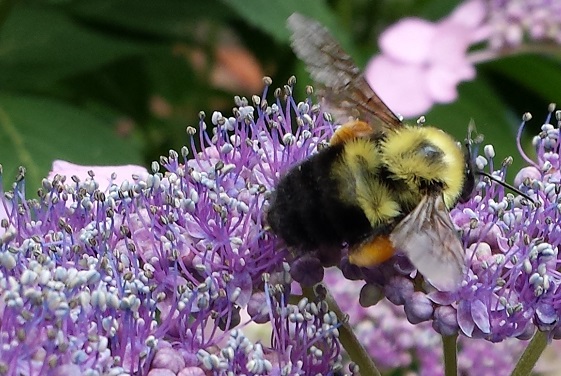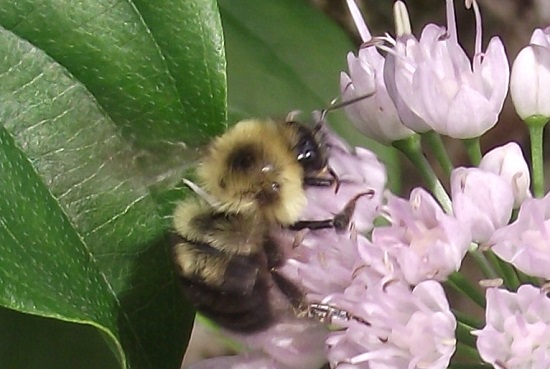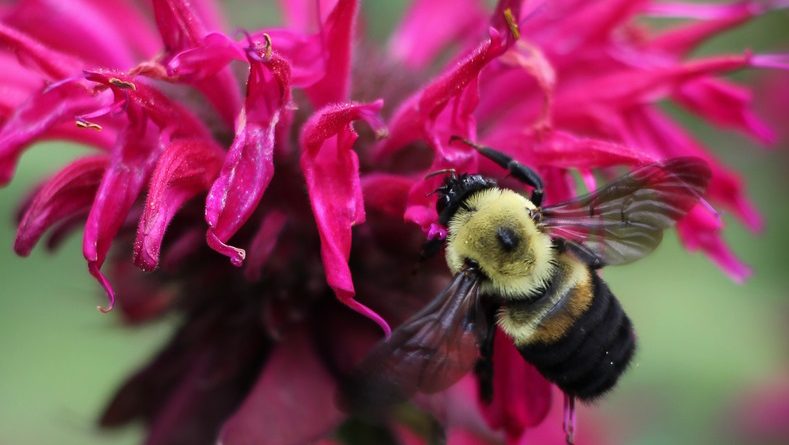January 21, 2017 – The Plight of the Bumble Bee
![]() Mike and Peggy talk to two experts–Allen Lawrance from Chicago’s Peggy Notebaert Nature Museum and Rich Hatfield from the Xerces Society for Invertebrate Conservation–about the recent decision by the U.S. Fish and Wildlife Service to list the rusty patched bumble bee (Bombus affinis) as an endangered species under the Endangered Species Act.
Mike and Peggy talk to two experts–Allen Lawrance from Chicago’s Peggy Notebaert Nature Museum and Rich Hatfield from the Xerces Society for Invertebrate Conservation–about the recent decision by the U.S. Fish and Wildlife Service to list the rusty patched bumble bee (Bombus affinis) as an endangered species under the Endangered Species Act.
Another one bites the dust?
On Tuesday, January 10, the U.S. Fish and Wildlife Service sent out an email with this announcement:
The U.S. Fish and Wildlife Service is listing the rusty patched bumble bee (Bombus affinis) as an endangered species under the Endangered Species Act. The final rule will publish in the Federal Register on January 11, 2017 and become effective on February 10, 2017.
Just 20 years ago, the rusty patched bumble bee was a common sight, considered abundant across 28 states, the District of Columbia and two Canadian provinces. Since then, it has experienced a swift and dramatic decline with abundance and distribution plummeting by about 87 percent. Today, we can find the rusty-patched bumble bee in only a few places within 13 states and 1 province: Illinois, Indiana, Iowa, Maine, Maryland, Massachusetts, Minnesota, North Carolina, Ohio, Pennsylvania, Tennessee, Virginia, Wisconsin – and Ontario, Canada.
Causes of the decline in rusty patched bumble bee populations are believed to be loss of habitat; disease and parasites; use of pesticides that directly or indirectly kill the bees; climate change, which can affect the availability of the flowers they depend on; and extremely small population size. Most likely, a combination of these factors has caused the decline in rusty patched bumble bees.
 One of the people who received that message was Allen Lawrance, the Associate Curator of Entomology at the Peggy Notebaert Nature Museum. He works Doug Taron, Chief Curator at Notebaert, a friend of this show who was on the program just last August. Lawrance works in a number of different capacities including managing the butterflies in the Judy Istock Butterfly Haven, rearing locally imperiled butterflies for their butterfly restoration project, and assisting Doug with running the Illinois Butterfly Monitoring Network.
One of the people who received that message was Allen Lawrance, the Associate Curator of Entomology at the Peggy Notebaert Nature Museum. He works Doug Taron, Chief Curator at Notebaert, a friend of this show who was on the program just last August. Lawrance works in a number of different capacities including managing the butterflies in the Judy Istock Butterfly Haven, rearing locally imperiled butterflies for their butterfly restoration project, and assisting Doug with running the Illinois Butterfly Monitoring Network.
He also does beekeeping on the rooftop of the museum, which brings us to today’s show. He notes that The Peggy Notebaert Nature Museum is serving as a lead partner in the Chicago Wilderness Priority Species for the rusty patched bumble bee along with three other priority species, the monarch butterfly, regal fritillary, and smooth green snake.
This morning he is joined by Rich Hatfield from the Xerces Society for Invertebrate Conservation. He is their Senior Endangered Species Conservation Biologist, and is helping to lead the fight to keep the rusty patched bumble bee from going extinct. (And I can’t believe that I actually have to write sentences like that.)
 Rich sent us a bunch of links, and rather than have me distill all–or even part–of the information in them, I’m going to let you do that yourself. Here they are:
Rich sent us a bunch of links, and rather than have me distill all–or even part–of the information in them, I’m going to let you do that yourself. Here they are:
- Bumble Bee Watch – a citizen science website to track and conserve bumble bees.
- Conserving Bumble Bees – bumble bee conservation guidelines for land managers
- Bring Back the Pollinators Campaign – a great place for folks to find information about creating habitat to help pollinators
- Fact Sheet: Rusty Patched Bumble Bee (Bombus affinis) -USFWS rusty patched bumble bee info page
- Lady Bird Johnson Wildflower Center plant database – information about bumble bee friendly plants
- Project Bumble Bee – a Facebook page about the Xerces Society conservation campaign to protect bumble bees and engaging the public in their efforts
That should certainly get you started. If you have any questions about how to save bumble bees (I still can’t believe that I have to write that!), call us during the show at 847-475-1590. Or connect on Facebook at The Mike Nowak Show, on Twitter at @MikeNow or just write to mike@mikenowak.net.


